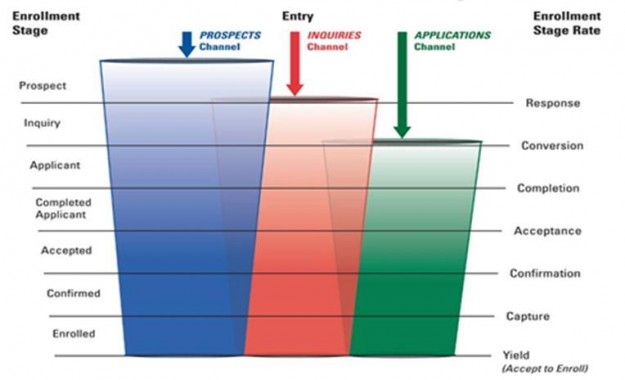Higher ed marketers do a lot of different things to keep their higher ed institutions in business but at the core of our responsibilities is student recruitment. For simplicity, we describe the recruitment process as a funnel but these days it seems to me more like a labyrinth than a funnel. Here is a good representation of the funnel, (created by Noel-Levitz) that nicely captures the key stages of recruitment and emphasizes the important point that prospects, inquiries and applicants make up different segments in the funnel. Regardless of its complexity, when the word comes down that you need more bottoms in seats, your challenge is to efficiently and cost effectively widen that funnel and increase its output of registered students.
Here are four digital marketing levers you can apply (with details attached), to help widen your funnel and drive more registrations.
1) Increase your website traffic.
Pretty obvious, I know, but it is not what most people think of first although it probably should be. Your website is likely your very best source of prospective students. Prospects coming to an institution’s site from search generally convert at a higher rate than almost any other type of prospect, so:
- invest in search engine optimization so you get found by your target audience.
- implement a good all round content strategy to help feed and bolster your SEO rankings
- use Pay Per Click advertising to produce more traffic. Caution here because it is usually of lower “quality” and it stops immediately when you stop spending money. Use it for highly targeted campaigns, and to help you build your brand and reputation in the market, managing it carefully so you don’t waste money.
- If you are not producing video for your site and backing that up on your YouTube channel you are missing a big opportunity. Searches on education terms on YouTube grew by 25 % in 2013 Q4. Get there now.
2) Capture more leads on your website
Some institutions spend a lot of money purchasing leads from academic web portals. It’s time to take all the lessons learned from those lead “developers” and apply them to your own website.
- Position lead generation forms strategically within your content page flow so that you are there with a lead form when prospect interest is highest.
- Create different landing pages and forms to capture leads at different stages in the recruitment cycle.
- Simplify your forms for optimal performance i.e. reduce the number of fields required, and always ask for a phone number so you can call them.
- Use value based calls-to-action, not just “Submit”. (When was the last time you submitted to anything?)
3) Increase the number of student that visit your campus
Campus visits continually rate as one of the most effective recruitment strategy used by colleges and universities. Clearly if you can get your prospective students on campus and give them a great experience, you have a good chance at registering them. So work on increasing the number by promoting campus visits, comprehensively across the funnel and:
- Have a robust campus visit program targeting students at different stages in the funnel. For example, target juniors, seniors, admitted students separately
- Add a virtual tour to your website. Research indicates that it increases the number of students who come later in person.
- Roll out the red carpet digitally to get students to come in person. Seriously invest in the content, design, and forms on your visits page. A/B test variations to the content, calls to action, and buttons to improve your conversion rate.
4) Increase the number of student applications
This is a difficult outcome to effect directly but there are things that will help increase applications. Students are submitting more applications today than they have in the past so be careful how your measure overall increases in the number of applications that you receive. A recent survey indicated that 29% of students submit applications to 7 or more institutions. Get your share by:
- Thoughtfully engaging prospective students with social media at application time. It is at this stage in the process that social media really shines and students are most likely to engage with advisors.
- Really optimize your application forms. Use plain simple English. Eliminate requests for unneeded info. Break up web forms into multipart forms with progress indicators. Allow prospect to start a form, leave it incomplete but able to log in later to finish. Partial info is better that none, and you can phone them if it doesn’t all come in.
What other strategies and tactics have you applied to expand your funnel?






